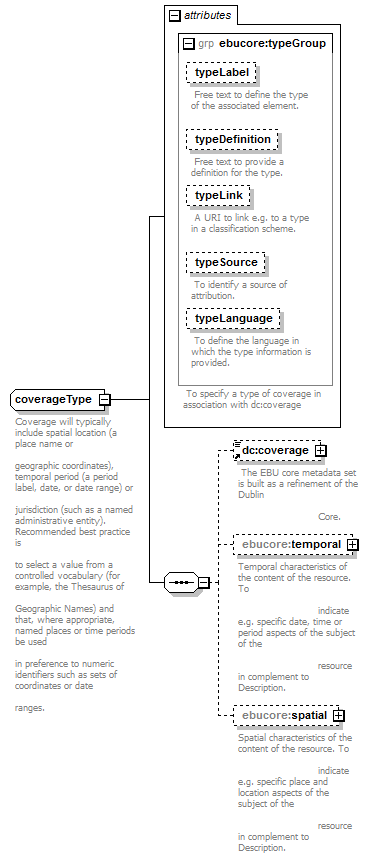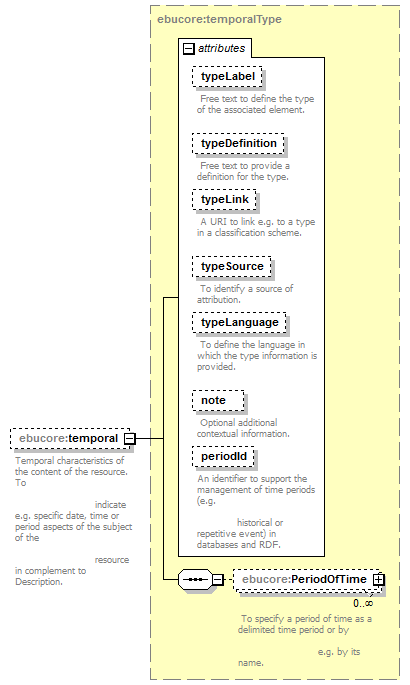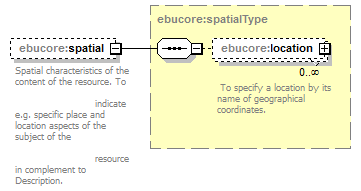| diagram |  |
||||||||||||||||||||||||||||||||||||||||||||||
| namespace | urn:ebu:metadata-schema:ebuCore_2014 | ||||||||||||||||||||||||||||||||||||||||||||||
| children | coverage ebucore:temporal ebucore:spatial | ||||||||||||||||||||||||||||||||||||||||||||||
| used by |
|
||||||||||||||||||||||||||||||||||||||||||||||
| attributes |
|
||||||||||||||||||||||||||||||||||||||||||||||
| annotation |
|
||||||||||||||||||||||||||||||||||||||||||||||
| source | <xs:complexType name="coverageType"> <xs:annotation> <xs:documentation>Coverage will typically include spatial location (a place name or geographic coordinates), temporal period (a period label, date, or date range) or jurisdiction (such as a named administrative entity). Recommended best practice is to select a value from a controlled vocabulary (for example, the Thesaurus of Geographic Names) and that, where appropriate, named places or time periods be used in preference to numeric identifiers such as sets of coordinates or date ranges.</xs:documentation> </xs:annotation> <xs:sequence> <xs:element ref="dc:coverage" minOccurs="0"> <xs:annotation> <xs:documentation> The EBU core metadata set is built as a refinement of the Dublin Core. </xs:documentation> </xs:annotation> </xs:element> <xs:element name="temporal" type="ebucore:temporalType" minOccurs="0"> <xs:annotation> <xs:documentation>Temporal characteristics of the content of the resource. To indicate e.g. specific date, time or period aspects of the subject of the resource in complement to Description. </xs:documentation> </xs:annotation> </xs:element> <xs:element name="spatial" type="ebucore:spatialType" minOccurs="0"> <xs:annotation> <xs:documentation>Spatial characteristics of the content of the resource. To indicate e.g. specific place and location aspects of the subject of the resource in complement to Description. </xs:documentation> </xs:annotation> </xs:element> </xs:sequence> <xs:attributeGroup ref="ebucore:typeGroup"> <xs:annotation> <xs:documentation> To specify a type of coverage in association with dc:coverage </xs:documentation> </xs:annotation> </xs:attributeGroup> </xs:complexType> |
element coverageType/temporal
| diagram |  |
||||||||||||||||||||||||||||||||||||||||||||||||||||||||||||||
| namespace | urn:ebu:metadata-schema:ebuCore_2014 | ||||||||||||||||||||||||||||||||||||||||||||||||||||||||||||||
| type | ebucore:temporalType | ||||||||||||||||||||||||||||||||||||||||||||||||||||||||||||||
| properties |
|
||||||||||||||||||||||||||||||||||||||||||||||||||||||||||||||
| children | ebucore:PeriodOfTime | ||||||||||||||||||||||||||||||||||||||||||||||||||||||||||||||
| attributes |
|
||||||||||||||||||||||||||||||||||||||||||||||||||||||||||||||
| annotation |
|
||||||||||||||||||||||||||||||||||||||||||||||||||||||||||||||
| source | <xs:element name="temporal" type="ebucore:temporalType" minOccurs="0"> <xs:annotation> <xs:documentation>Temporal characteristics of the content of the resource. To indicate e.g. specific date, time or period aspects of the subject of the resource in complement to Description. </xs:documentation> </xs:annotation> </xs:element> |
element coverageType/spatial
| diagram |  |
||||||
| namespace | urn:ebu:metadata-schema:ebuCore_2014 | ||||||
| type | ebucore:spatialType | ||||||
| properties |
|
||||||
| children | ebucore:location | ||||||
| annotation |
|
||||||
| source | <xs:element name="spatial" type="ebucore:spatialType" minOccurs="0"> <xs:annotation> <xs:documentation>Spatial characteristics of the content of the resource. To indicate e.g. specific place and location aspects of the subject of the resource in complement to Description. </xs:documentation> </xs:annotation> </xs:element> |
XML Schema documentation generated by XMLSpy Schema Editor http://www.altova.com/xmlspy